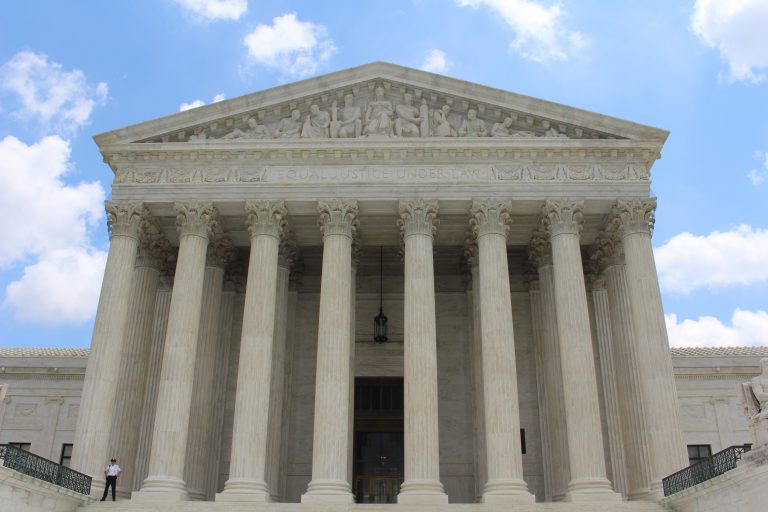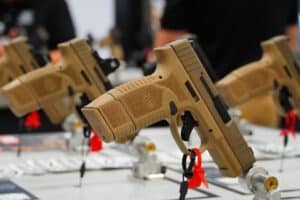The Supreme Court announced on Monday it would take the first gun-carry case in its history.
The Court agreed to hear a case challenging New York’s restrictive gun-carry law. The case, filed by New York State Rifle & Pistol Association and backed by the NRA, argues New York’s refusal to grant gun-carry permits to law-abiding residents on the basis of self-defense violates the Second Amendment. It is the first case dealing with gun carry outside the home to be considered by the Court.
The case’s outcome will have massive implications for gun laws across the country. If the Supreme Court decides to strike down New York’s restrictive law, it could create a cascade effect toppling restrictive gun-carry laws in several other states, including California and New Jersey. In addition to New York, seven other states currently use a “may-issue” approach to gun-carry permits, which allows government officials to deny permits even when the applicant passes a background check and finishes the required training. Those may-issue states are also disproportionately populous, making up more than a quarter of the U.S. population.
The Court could also set a new standard for deciding important questions in other Second Amendment cases, something gun-rights advocates have long wanted.
The case is the culmination of more than 11 years of legal activism by gun-rights supporters. The Supreme Court has not ruled on the merits of a substantial gun case since its landmark decisions in Heller and McDonald, where it found the Second Amendment protected the right to own common firearms, including handguns, for self-defense inside the home. Gun advocates have long pursued, and gun-control advocates long feared, a case expanding that recognition beyond the home. The appointment of Amy Coney Barrett to replace Ruth Bader Ginsburg last fall raised hopes the Court would finally address the issue again.
The Court considered another gun case out of New York last year but ruled it was moot after the state changed its law to give plaintiffs what they wanted. New York has not yet tried a similar move to avoid the gun-carry case.
All six justices appointed to the Court by Republicans have issued opinions in favor of extending Second Amendment protections in their careers. Four of the justices have also publicly chastised the court for not taking more Second Amendment cases. Justice Clarence Thomas has slammed the Court multiple times for treating the Second Amendment differently from other constitutional amendments. Last year, he described the Court as ignoring the issue.
“This Court would almost certainly review the constitutionality of a law requiring citizens to establish a justifiable need before exercising their free speech rights,” Thomas wrote in a dissent when the Court refused to hear any of a collection of different gun cases. “And it seems highly unlikely that the Court would allow a State to enforce a law requiring a woman to provide a justifiable need before seeking an abortion. But today, faced with a petition challenging just such a restriction on citizens’ Second Amendment rights, the Court simply looks the other way.”
Gun-rights and gun-control groups have long viewed the Court as favorable to revisiting the gun issue and broadening the current limits of Second Amendment protections. They have been engaged in a decade-long legal battle over whether cases even make it to the High Court.
New York State Rifle & Pistol Association argued in its petition that it is time for the Court to end the dance.
“Perhaps the single most important unresolved Second Amendment question after this Court’s landmark decisions in District of Columbia v. Heller, and McDonald v. City of Chicago, is whether the Second Amendment secures the individual right to bear arms for self-defense where confrontations often occur: outside the home,” the group said in its petition. “The text, history, and tradition of the Second Amendment and this Court’s binding precedents compel the conclusion that the Second Amendment does indeed secure that right.”







4 Responses
How strong will the court’s rubric for “reasonable” regulations be on carry permits? Will they construct tests that force shall issue as a minimum, go beyond that, or just state broadly that a right to carry firearms outside the house be allowed?
I have my doubts they will go beyond shall issue but get ready for a Clarence Thomas concurrence smack down on the dissenting opinions, especially if one is written by the ‘conservative’ chief justice.
“Precedence” is the term for what you can fit in the same cavity when you #NaCL, once it is determined that you were wrong. Or else, the rest of us are stuck for whatever you let spill from your head in adjudicating a matter wherein a potentially weak premise, or not a full and vigorous defense was implemented.
I can’t understand the feigned retardation of, not only the courts but, the defenders of 2A to apply basic logic provided by our “Founders/Framers” who DECLARED (so that no one would later have to hem and haw about “what the Founders were thinking at the time”) in Paragraph 2nd of The Declaration of Independence [you know, our Great Nation’s Birth Certificate that cannot be amended or repealed, and wherein our Founders stated that our rights are from our CREATOR (who doesn’t happen to be a member of our “government”) and that they are unalienable (later documents attempting to delineate them prove that they are, protections AGAINST “government” and THEREFORE government cannot also be the protector, nor the entity doling out the means, or the permission to obtain the means to that protection)] that it is our “duty” to replace our government “whenever” we deem necessary. THERE IS NO WAY our Founders wrote that, but yet still intended us to have to ask, the government that needed replacing, for the means, OR THE PERMISSION to obtain the means to do so.
Therefore the 2nd Amendment demands parity of arms with our government, and it is not our fault what that parity might entail.
“A well regulated Militia, being necessary to the security of a free State, the right of the people to keep and bear Arms, shall not be infringed.”
A well regulated Militia [FOUNDERS: which is what we want instead of a standing Army], being necessary to the security of a free State [FOUNDERS: which is what we want without having a standing Army], the right of the people to keep and bear Arms, shall not be infringed [FOUNDERS: because, when we draw from the ONLY SOURCE for such a Militia it will be REALLY HANDY for those people to have their own arms, and a working knowledge of how to use them].
Simple logic people, and damn simple legal argument.
I wouldn’t count on Bennet to do the right thing. We have already witnessed her siding with the leftist.
Threeper –
“Bennet?”
How can you expect to be taken seriously when you can’t even remember Amy Coney Barrett’s name?